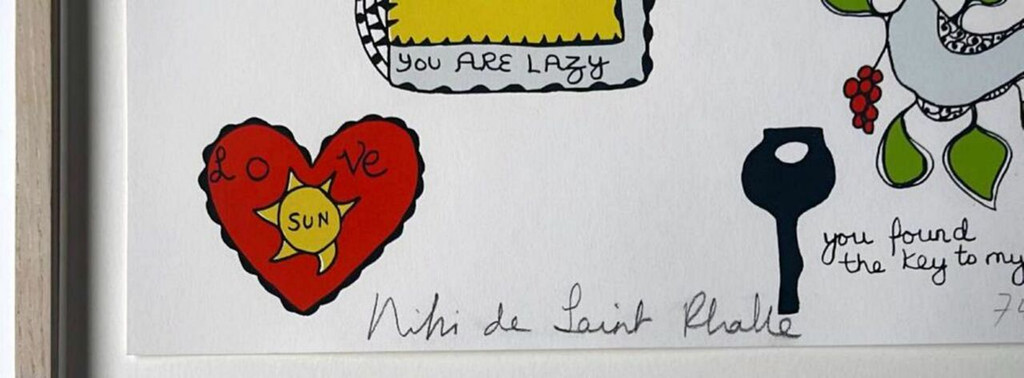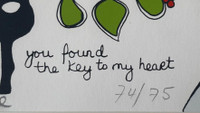
An Educated Collector is Our Best Client
In business for nearly two decades, we are a well established, popular contemporary art boutique specializing in expertly chosen, blue chip prints, multiples, uniques, books, ephemera and merchandise at different price points, with a focus on the secondary market. Please click on the "Contact Us" button at the bottom of this page for questions about any work, pricing and/or to arrange to visit our showroom/gallery - located in between Manhattan's Flatiron and Chelsea Flower Districts.
Niki de Saint Phalle, I Rather Like You A Lot You Fool, 1970
CONTACT GALLERY FOR PRICE
Description
Niki de Saint Phalle
I Rather Like You A Lot You Fool, 1970
Silkscreen on wove paper
Signed and numbered 74//75 in graphite pencil on the front
Frame included
Signed and numbered 74//75 in graphite pencil on the front
A delightful and clever work. The text reads:
I Rather Like You A Lot You Fool
Not much Hair
Crooked Nose
You are not very rich
You’re not terribly intelligent
You smoke too much pot
You are lazy
A bit crazy
But I like the way you touch me
I like the way you look at trees and flowers
I like the way you look at me
You found the key to my heart
This work is elegantly floated and framed in a museum quality wood frame with UV plexiglass
Dimensions:
Framed
23.5 vertical by 28.5 by 1.5 inches
Artwork:
19.5 by 25.5 inches
"Throughout her long and prolific career Niki de Saint Phalle, a former cover model for Life magazine and French Vogue, investigated feminine archetypes and women’s societal roles... Her Nanas, bold, sexy sculptures of the proverbial everywoman, are playful and empowering, while [her graphic works] offer humorous takes on girlhood obsessions..." - The Brooklyn Museum
Biography of Niki de Saint Phalle
Childhood
Niki de Saint Phalle was born in France in 1930 to an aristocratic Catholic family. She had an American mother, a French banker father, four siblings, and grew up bilingual in French and English. Her father lost his wealth during the Great Depression and the family moved to the US in 1933, where Saint Phalle attended Brearley School, a girls' school in New York City. Saint Phalle reported later in her life, in an autobiography titled Mon Secret (1994), that her father had sexually abused her from age 11.
From an early age, Saint Phalle pushed boundaries in her artistic and personal life. Though she found Brearley School to be a formative experience, later claiming that it was there she became a feminist, she was expelled for painting the fig leaves covering the genitals of statues on the school's campus red. She then attended Oldfields School in Maryland, graduating in 1947. As a young woman, Saint Phalle also worked as a model, appearing on the front covers of Life Magazine and Vogue.
When she was 18, Saint Phalle eloped with Henry Matthews, an author and childhood friend. While Matthews studied music at Harvard University, Saint Phalle began to explore painting, and gave birth to her daughter Laura in 1951, when she was 20 years old.
Early Training and work
In 1952, the Matthews and Saint Phalle moved to Paris, where he continued to study music and Saint Phalle studied theater. The couple traveled extensively in Europe, gaining exposure to art by the Old Masters. The following year, Saint Phalle was diagnosed with a "nervous breakdown" and hospitalized in a psychiatric facility. She was encouraged to paint as a form of therapy, and consequently gave up her theater studies in favor of becoming an artist.
The couple moved to Mallorca off the coast of Spain, where their son Philip was born in 1955. During this time, Saint Phalle developed her imaginative, self-taught style of painting, experimenting with a variety of forms and materials. She also discovered the architecture of Antonio Gaudi, which had a strong influence on her work. Gaudi's Park Guell in Barcelona was instrumental in Saint Phalle's early conceptualization of the elaborate sculpture garden she would fulfill much later in her career.
Mature Period
At the end of the 1950s, Saint Phalle and her husband moved back to Paris. In 1960, however, the couple separated and Saint Phalle moved to a new apartment, established a studio, and met artist Jean Tinguely, with whom she would collaborate artistically. Within a year, they had moved in together and begun a romantic relationship.
Saint Phalle became part of the Nouveau Réalisme movement along with Tinguely, Yves Klein, Arman and others. She was the only woman in the group. Her first solo exhibition in 1961 punctuated a dynamic period of Saint Phalle's early career, and she met a number of influential artists living in Paris at the time, such as Robert Rauschenberg and Jasper Johns, whose use of found objects was to have a strong influence on Saint Phalle's work. She was also friendly with Marcel Duchamp, who first introduced her and Tinguely to Salvador Dalí. The three artists traveled to Spain together to an event celebrating Dali's work, in which a life-sized bull sculpture was detonated with fireworks.
In 1963, Tinguely and Saint Phalle moved to an old house just outside Paris, where she began to work on architectural projects as well as her renowned shooting paintings. In 1971, she designed her first building (a residence in the south of France), traveled to India and Egypt to study Eastern architecture, and married Tinguely.
Her most famous and prolific series of works, the Nanas, were begun in the mid-1960s and inspired by a friend's pregnancy, her reflections on archetypal feminine forms, and the vexed positions that women occupy in modern, patriarchal societies. 'Nanas,' a French slang word roughly equivalent to 'broads,' is a title that encapsulates the theme of the everywoman as well as the casual denigration that closely accompanies the rhetorical grouping of women as a social category.
In 1974, Saint Phalle suffered from a serious lung illness and was advised by her doctors to spend some time in Switzerland to recuperate. While she was there, she met childhood friend Marella Caracciolo Agnelli, who was then the wife of Fiat chairman Gianni Agnelli. Marella was a well-connected socialite with a penchant for collecting art, and Saint Phalle told her about her vision of creating an elaborate sculpture garden of Tarot symbology. Caracciolo Agnelli proposed an area of land in Tuscany as a site, and initiated the garden work that would define the next 20 years of Saint Phalle's artistic efforts.
Late Period
In 1978, the foundations were laid for the Tarot Garden, and Saint Phalle created the first sculptural models for it. Construction began on the first large-scale sculpture in 1980, and in 1982 Saint Phalle completed The Empress, a sculptural building designed in the shaped of a sphinx. This structure became her studio and home for the next decade.
Saint Phalle was one of the first artists to get involved in AIDS outreach and prevention programs in the 1980s, designing prints to raise awareness about the disease. The 1980s were also the most prolific period in the Nanas series, and marked a time when her interests in the cultural and biological systems constructing femininity were their most intricately developed.
Jean Tinguely died in Switzerland in 1991, and Saint Phalle began to make a series of kinetic sculptures, his chief sculptural medium, to honor his memory. In 1994, Saint Phalle moved away from Tuscany to live in La Jolla in California. She lived there until her death in 2002.
The Legacy of Niki de Saint Phalle
The Nouveau Realisme movement, and Niki de Saint Phalle's work in particular, had a significant effect on the development of conceptual art. Her works often combined performance and plastic art in new ways, blending and dismantling hierarchies between painting, sculpture, and performance in a way that would influence conceptual artists such as Joseph Beuys and Lawrence Weiner. She performed some of her Shooting Pictures for Robert Rauschenberg, Jasper Johns, Ed Ruscha and Larry Bell, and influenced their thinking toward developing new and hybrid forms rather than refining single medium-specificity.
As a feminist, Saint Phalle's unique style championed the female body and female sexuality. Her work would inspire generations of women artists working with the problem and challenge of representing the female body (notably, Louise Bourgeois' ambiguous, supple fabric sculptures of female forms). Saint Phalle also left behind a significant legacy of public sculpture, both in her Tarot Garden in Tuscany and in other locations around the world.
-The Art Story

















